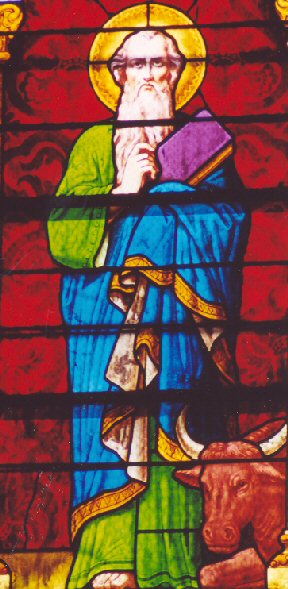 The
two disciples recounted what had taken place on the way, and how Jesus was made
known to them in the breaking of bread.
The
two disciples recounted what had taken place on the way, and how Jesus was made
known to them in the breaking of bread.Learn from the Risen Lord
by Rev. Joseph M. Rampino
Reprinted with permission of "The Arlington Catholic
Herald"
Home Page
To Sunday Gospel Reflections Index
Written to explain that
Christ came to save everyone.
 The
two disciples recounted what had taken place on the way, and how Jesus was made
known to them in the breaking of bread.
The
two disciples recounted what had taken place on the way, and how Jesus was made
known to them in the breaking of bread.
While
they were still speaking about this, he stood in their midst and said to them,
"Peace be with you." But they were startled and terrified and thought that
they were seeing a ghost. Then he said to them, "Why are you troubled?
And why do questions arise in your hearts? Look at my hands and my feet,
that it is I myself. Touch me and see, because a ghost does not have flesh
and bones as you can see I have." And as he said this, he showed them his
hands and his feet. While they were still incredulous for joy and were
amazed, he asked them, "Have you anything here to eat?" They gave him a
piece of baked fish; he took it and ate it in front of them.
He
said to them, "These are my words and that I spoke to you while I was still with
you, that everything written about me in the law of Moses and in the prophets
and psalms must be fulfilled." Then he opened their minds to understand
the Scriptures. And he said to them, "Thus it is written that the Christ
would suffer and rise from the dead on the third day and that repentance, for
the forgiveness of sins, would be preached in his name to all the nations,
beginning from Jerusalem. You are witnesses of these things."
From her most ancient days, the church has taken this time after Easer for a practice known as mystagogy, during which she would teach the newly-baptized Christians what had taken place when they received the sacraments. This is actually part of why we still hear the stories of the risen Christ's appearances to the disciples during the Easter season. We are not simply recalling the historical events surrounding the Resurrection, but we are learning from the Lord himself about the mysteries of the Christian life we have all received. Today, we do not simply hear about Christ's appearance to the disciples, but the church calls us to consider in greater depth both the Eucharist and our relationship with the Scriptures.
First, this story leads us to consider Jesus' real presence in the Eucharist. The Gospel begins today with the end of the road to Emmaus story. Two disciples had encountered Jesus while traveling on the evening of Easter Sunday, and had not recognized him ;until he took bread, blessed it, and broke it for them. After the breading of the bread, they recognized him, but he immediately disappeared. Since those verbs - taking, blessing, breaking the bread - have always had a Eucharistic meaning, the early church understood that scene to mean something very specific. The disciples recognized Christ in the moment his visible presence passed into the bread that he offered, almost as though he vanished into Holy communion before their eyes. Thus, the Jesus who appeared to the disciples had already become the Eucharistic Lord for the new church, which makes his continuing identity and reality so important.
As soon as the Emmaus disciples recount their story abut the breaking of the bread, Christ in fact appears, precisely to demonstrate that he is really alive, and that he has remained himself. The one who had disappeared into the sacrament of the Eucharist now stands before the apostles whole and entire, still alive, still real, with a body of "flesh and bones." He was no ghost, but the same real man he was before, glorified but not changed into someone else. Now, just as then, Christ's visible presence has passed into the sacraments without taking away from his real human presence, body and soul, in heaven. When we receive Holy Communion, it is the whole, living, historical Christ whom we receive.
Second, this story reminds us how we as Christians relate to the Scriptures. Just as he had taught the Emmaus disciples, Christ teaches the apostles, saying, "Everything written about me in the law of Moses and the prophets and psalms (had to be) fulfilled." According to Jesus himself, the whole Old Testament refers to him and announces him. We can sometimes be tempted to read the Old Testament in isolation from the life of Jesus, but ;it is none other than Christ who teaches us that the Old Testament finds its true meaning in the Gospels. Everything present in the Old Testament predicts ;him, prefigures him, or shows what he has come into the world to save. Figures such as Abel, Noah, Isaac, Jacob, Joseph, Joshua ad David are all shadows of Jesus to come; Jesus is the true version of each one, as well as the fulfillment of every other passage in the Scriptures.
During this Easer season, the church invites us to learn the truth about what it means to be Christian from the risen Lord himself. If at his instruction, we come to believe more deeply in his real presence in Holy Communion and see his face in every passage of the Scriptures, then we have become more Christian, and Jesus' Resurrection has taken deeper root in us.